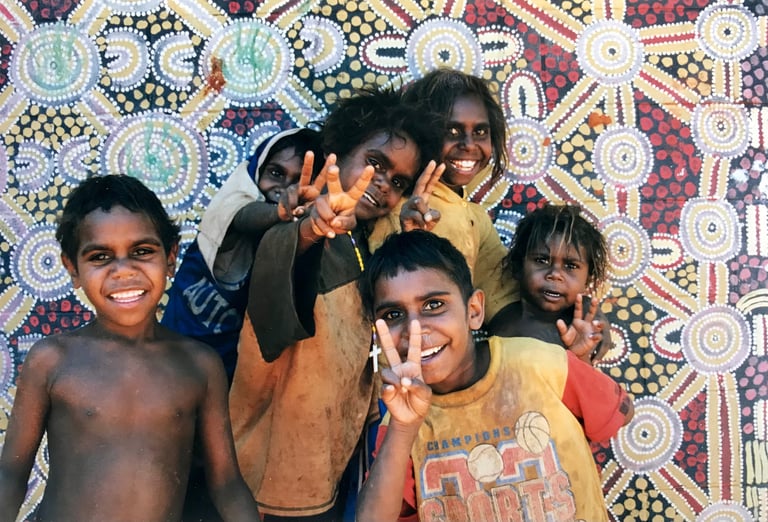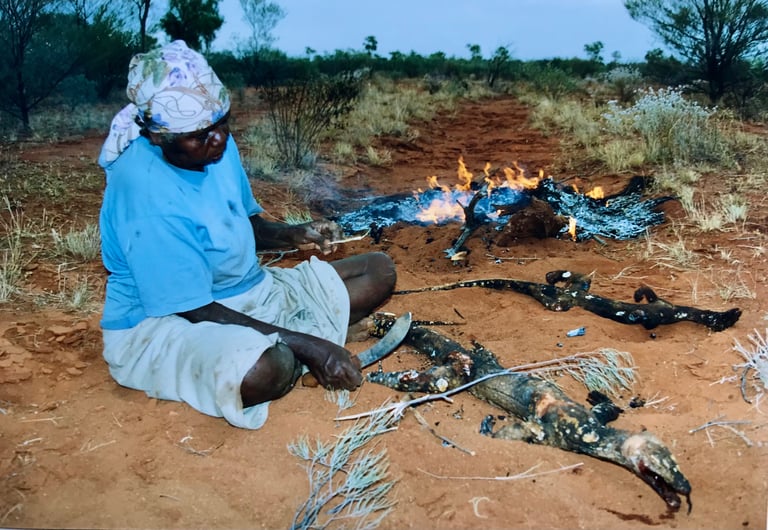Contemporary Australian Aboriginal artworks contain an extraordinary spatial and spiritual vision that incorporates non-dualistic vision and a profound element of sense of place. Perspective within Aboriginal culture is a high ground both literally and metaphorically. For land-based cultures, a high vantage point is valuable for outlook and survival, and to see a situation from all sides implies wisdom and compassion. In sharp contrast, Western culture has acquired an appetite for a ‘view’ and we too frequently disengage from fully being in place. We travel far to see a panoramic view, take a photograph or buy a postcard, and return home feeling unsatisfied that our expectations are yet again not met.
For traditional Australian Aboriginal people, survival is dependent upon their sensitivity to their environment, to oneself, and others. Their experiential knowledge is learned from elders from a very young age as they develop a fine awareness to the smallest change in their surroundings, from imprints in the sandy earth, to wind direction, temperature, and proximity of water sources. Communication and sensitivity are essential, and often non-verbal. Aboriginal artists are scribes of profane and mystical events, and their paintings are maps of experience. Each time I fly over the Australian desert, I look down over an infinity of ochre-red expanses of colour punctuated by a myriad of dots of spinifex, casuarina, and waterholes that mirror the dots on Aboriginal paintings. Yet Aboriginal paintings carry far more profound layers of meanings than mere pictorial depiction.
The gesture a traditional Australian Aboriginal painter makes with the new medium of acrylic paint has a life born from ancient Dreamings, ancestors’ teachings, and experience. At the outstation of Utopia, artists paint canvases flat on the ground of their ‘country’, their spiritual homeland. Women often depict the ceremonial ochre body painting patterns of awelye in designs specific to their Dreamings. The men and women are highly creative and innovative in how they paint their Dreamings, for while it is forbidden by Aboriginal Law for a person to paint another person’s Dreaming, each individual artist is free to express their interpretations of their Dreamings.
Their act of painting goes far beyond the painted canvas surface: it is about reciprocity and relationship, honouring ancestral ‘country’ for which they are custodians. Dr. Peter Sutton, curator of the South Australian Museum, recognised that “There is a very strong connection between the use of symmetry in Aboriginal art and the powerful commitment to the balance of reciprocity, exchange and equality in Aboriginal thought. For example, in many parts of Australia you cannot hold a ceremony with just your own group. You have to balance it by having members of the other side present. These moieties are something we do not have in our society. It would be like saying you cannot have a Catholic Mass without having Protestants present. This preoccupation with balance is evident in the composition of paintings.” (Sutton, 1989)
Traditional Aboriginal art appears abstract yet it has a highly specific narrative that comes from an ancient history of rock engraving, painting in ochres on cave walls, and ritual patterns made in the sand and on bodies during men’s and women’s separate ceremonies. What traditional Aboriginal artists now paint with acrylic on canvas is based on Aboriginal Law and obligations to each person’s ‘country’ and ancestors. The Dreamtime concept of time simultaneously encompasses past, present, and future. Dreaming stories and songs map the land, and are often sung onto canvases, bark, or the ground. Content, cosmology, culture, and art are one whole.
Tjurrkurpa, Dreamtime, is a term used to express the Aboriginal cosmology of creation stories, religious and social law, ancestors, and embodies the natural and spiritual forces of the Universe. It is believed that the natural features of the land were created by Dreamtime ancestral beings who moved across the newly created world creating its topography, flora, and fauna while naming each. The ritual nature and continuity of Dreamings are conserved through ceremonies and initiations where secrecy is closely maintained. Jo Anne Danzker said that “Protecting the Tjurrkurpa and the land is more than a concern that the stories and songs of how things came to be are not forgotten. For Yapa [Central Australian indigenous people] it is the protection of the essential nature of all things and of a unique way of being.” (Danzker: 1994)
The history of the modern Aboriginal acrylic dot painting movement began in 1971 at the government settlement of Papunya, 250 kilometres west of Alice Springs. It was a sad place where tribes had been forcibly taken when the government removed them from their sacred, ancestral lands. Geoffrey Bardon, the community art teacher at Papunya, encouraged a group of senior initiated Aboriginal men to make art from their own culture. The elders painted their Dreamings on small boards, then later onto canvas, and sold them in Alice Springs. By the 1980’s, Aboriginal women had also begun to paint. From a tradition of cave paintings, rock engravings, ceremonial ochre body painting, and ritual sand paintings made of ochres, blood, feathers, twigs and seeds, an outpouring of thousands of years of experience effortlessly flowed into the new acrylic paintings and became an internationally recognized and respected art movement.
Yet Dr. Peter Sutton gave a warning about how we perceive these extraordinary hybrid artworks: “You can know its visual aesthetic impact on you, but you need to approach the works on more than that narrow front if you are going to get into them deeply. It is really not enough and in a sense disrespectful and exploitative – if you want to put it into harsh terms – to go on treating Aboriginal artworks as objects of interior decoration without knowing their meaning. If you know nothing about the Dreaming story involved, all you have done is colonize it, remove it from its context and turn it into a bit of wallpaper.” (ibid.) Our appreciation of Aboriginal art must not be another form of cultural appropriation. Dr. Andrew Blake, the co-ordinator of Buku-Larrngay Arts Centre in Yirrkala in Arnhem Land, said of the bark painting tradition that “These works are the equivalent of religious icons. Each one bears the ‘Miny’tji’ or clan design and holds the essence of the clan identity in its pattern.”
The vast diversity of stylistic variation in Aboriginal art is complex and constantly evolving. Artists are based in urban and outback Australia, yet a common political element is present in all their work for they are declarations of their connection to sacred, ancestral land. Some bark paintings are literally ‘title deeds’ and have been used in successful claims for Aboriginal Land Rights. The people have a continuous cultural heritage despite successive Australian governments’ attempts to eradicate it. Since British colonisation in 1788, there has been an appalling, tragic history of enforced exile, massacres (referred to as ‘reprisals’), ‘stolen’ children, deaths in custody, high mortality rates, and racism. By the mid-1970’s, the link between political activism, the Land Rights movement, and the new painting movement was clearly established. As artist Charlie Tjaruru Tjungurrayi commented, “If I don’t paint this story some white fella might come and steal my country.” An amazing number of indigenous Australians now refer to themselves as artists, and it is equally amazing that indigenous Australians still wish to share their culture through their art. With all the negative intrusions of Western materialism into their culture, they have fully embraced acrylic painting, printmaking, sculpture, dance, music, writing, and drama as new ways to honour their ancestors, culture, and country. Art now helps maintain their ancient oral culture, educates young members of the community, brings much-needed financial agency, and is an act of profound generosity.
Reflections on Australian Aboriginal Art and Culture
Dr. Victoria King




Photographs by Victoria King taken in 1999 of the late Violet Petyarre preparing a perentie to cook and of children in front of the school at Utopia.
© Photographs and text copyright Dr. Victoria King 2025.